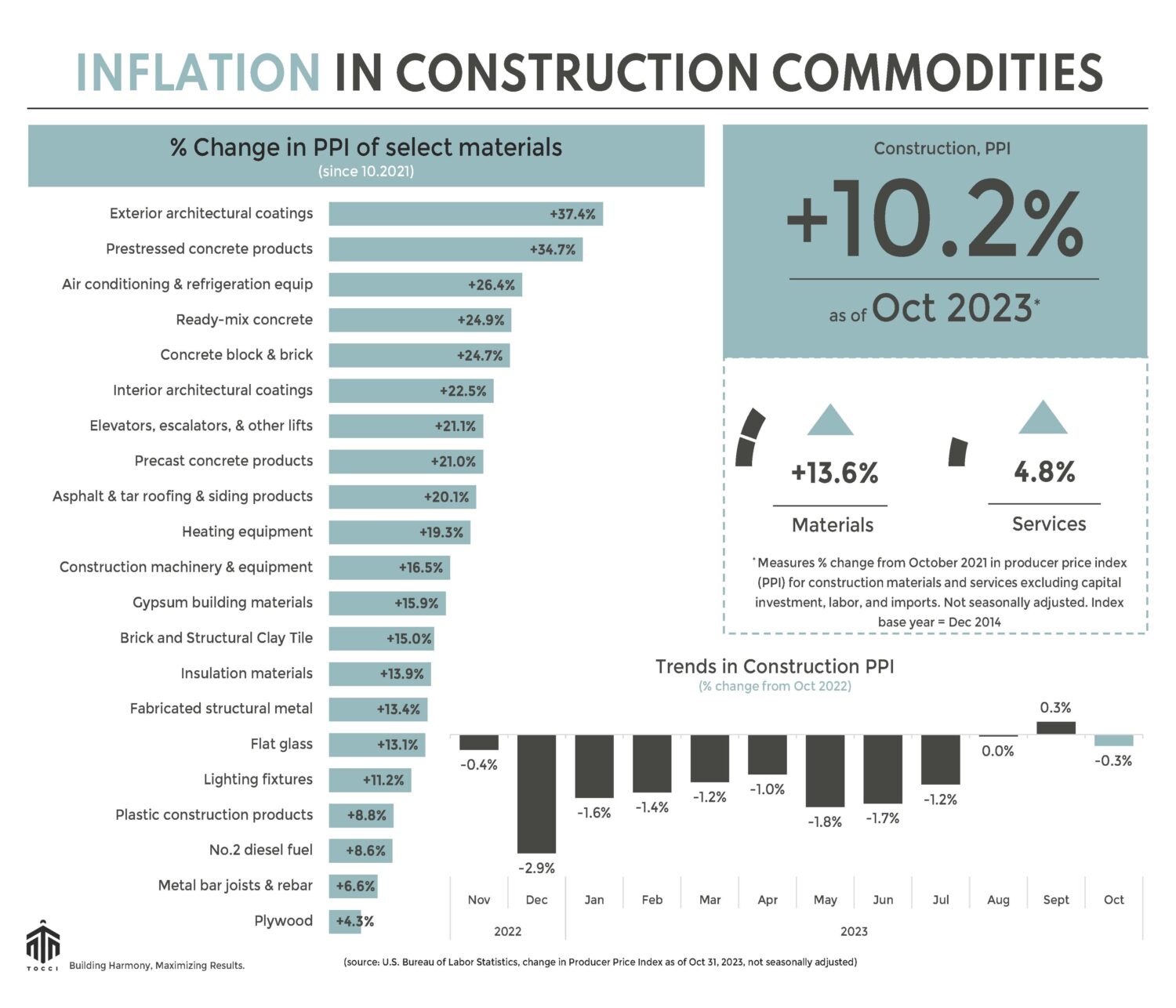November 2023 Commodities

Lumber futures rebound, steelmakers still hiking, and construction inflation relatively flat…
The Producer Price Index (PPI) for construction inputs (materials and services) fell by 0.59% in October compared to the previous month and shrunk by 0.28% compared to last year.
Lumber: In November, lumber futures climbed, almost tiptoeing as if hesitant to disturb the housing market. Lumber futures steadily surpassed $500 per thousand board feet (mbf); presently hovering above $525/mbf and marking a modest 14% increase over the past 30 days. Interestingly, these fluctuations have yet to be reflected in government data. The Producer Price Index (PPI) for softwood lumber recorded a 3.2% decline in October compared to the prior month and marked a year-on-year decrease of 16.3%.
Meanwhile, the National Association of Home Builders (NAHB)/Wells Fargo Housing Market Index (HMI) reported a fourth consecutive decline in homebuilder confidence during November. This decline, however, does not overshadow the persistent shortage of homes on the market, which continues to be a driving force behind new construction. According to the latest data on New Residential Construction, builders seem to be proceeding at a measured pace, with a modest 1.9% uptick in housing starts and a 1.1% increase in permits, month-on-month. It’s almost as if they’re constructing in slow motion. Overall, homebuilding activity remains subdued compared to the previous year, with starts and permits down 4.2% and 4.4%, respectively.
Lumber prices have somewhat stabilized this year after years of unusual volatility during the pandemic. However, mortgage rates began to soften in November. Homebuying fever is contagious and could potentially intensify if mortgage rates ease. Heightened demand for homeownership may catalyze homebuilding activity which “wood” increase demand for lumber, potentially derailing recent stability and introducing a new chapter of volatility.
STEEL and others: After a late-October rally, US hot-rolled coil (HRC) futures have been forging ahead in November, surpassing $875 per short ton (st). Notably, there has been a remarkable 27% upswing in the 30 days leading up to November 20th. HRC futures are up 34% from last year. Earlier in the month, steel juggernauts Nucor and US Steel hammered out another hike by raising their minimum HRC prices to $950/st. Cleveland-Cliffs moved to establish their minimum HRC prices at $1,000/st. This month, we received correspondence from a leading independent manufacturer of steel pipes and tubes in North America, informing us of a $150/ton increase in prices for new orders of structural steel products.
Although spot prices in metal markets have increased, government data and surveys have yet to fully capture the extent of this impact. In October, the PPI for steel mill products reported a 2.5% decline from the previous month and a 9.9% decrease year-on-year (not seasonally adjusted), highlighting the lag in government data compared to real-time market developments.
In nonmetallic mineral markets, concrete is cementing price hikes as well. Earlier this month, we were informed by a local cement supplier about a price increase of $20 per cubic yard, which will take effect on January 1, 2024. The Producer Price Index (PPI) for cement has increased by 8% year-to-date, while ready-mix concrete has seen a rise of 9.1%, and gravel and crushed stone have increased by 8.7%. On the other hand, there is some relief in the prices of no.2 diesel fuel and asphalt, with PPI decreasing by 9.1% and 3.4% from September, respectively. PPI for gypsum products declined by 1.2% in comparison to the previous year.
The winds of change are blowing, so hold on to your hard hats. Unexpected escalation in construction costs pose a material threat to project budget stability, potentially undermining investment returns. If your project isn’t penciling, reach out so we can ink some ideas together.
See below for a commodities snapshot, or click here for the full report.
